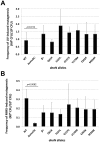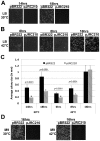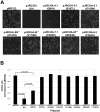A dnaN plasmid shuffle strain for rapid in vivo analysis of mutant Escherichia coli β clamps provides insight into the role of clamp in umuDC-mediated cold sensitivity
- PMID: 24896652
- PMCID: PMC4045847
- DOI: 10.1371/journal.pone.0098791
A dnaN plasmid shuffle strain for rapid in vivo analysis of mutant Escherichia coli β clamps provides insight into the role of clamp in umuDC-mediated cold sensitivity
Abstract
The E. coli umuDC gene products participate in two temporally distinct roles: UmuD2C acts in a DNA damage checkpoint control, while UmuD'2C, also known as DNA polymerase V (Pol V), catalyzes replication past DNA lesions via a process termed translesion DNA synthesis. These different roles of the umuDC gene products are managed in part by the dnaN-encoded β sliding clamp protein. Co-overexpression of the β clamp and Pol V severely blocked E. coli growth at 30°C. We previously used a genetic assay that was independent of the ability of β clamp to support E. coli viability to isolate 8 mutant clamp proteins (βQ61K, βS107L, βD150N, βG157S, βV170M, βE202K, βM204K and βP363S) that failed to block growth at 30°C when co-overexpressed with Pol V. It was unknown whether these mutant clamps were capable of supporting E. coli viability and normal umuDC functions in vivo. The goals of this study were to answer these questions. To this end, we developed a novel dnaN plasmid shuffle assay. Using this assay, βD150N and βP363S were unable to support E. coli viability. The remaining 6 mutant clamps, each of which supported viability, were indistinguishable from β+ with respect to umuDC functions in vivo. In light of these findings, we analyzed phenotypes of strains overexpressing either β clamp or Pol V alone. The strain overexpressing β+, but not those expressing mutant β clamps, displayed slowed growth irrespective of the incubation temperature. Moreover, growth of the Pol V-expressing strain was modestly slowed at 30°, but not 42°C. Taken together, these results suggest the mutant clamps were identified due to their inability to slow growth rather than an inability to interact with Pol V. They further suggest that cold sensitivity is due, at least in part, to the combination of their individual effects on growth at 30°C.
Conflict of interest statement
Figures








Similar articles
-
The Mutant βE202K Sliding Clamp Protein Impairs DNA Polymerase III Replication Activity.J Bacteriol. 2021 Nov 5;203(23):e0030321. doi: 10.1128/JB.00303-21. Epub 2021 Sep 20. J Bacteriol. 2021. PMID: 34543108 Free PMC article.
-
Elevated Levels of the Escherichia coli nrdAB-Encoded Ribonucleotide Reductase Counteract the Toxicity Caused by an Increased Abundance of the β Clamp.J Bacteriol. 2021 Nov 5;203(23):e0030421. doi: 10.1128/JB.00304-21. Epub 2021 Sep 20. J Bacteriol. 2021. PMID: 34543109 Free PMC article.
-
Genetic interactions between the Escherichia coli umuDC gene products and the beta processivity clamp of the replicative DNA polymerase.J Bacteriol. 2001 May;183(9):2897-909. doi: 10.1128/JB.183.9.2897-2909.2001. J Bacteriol. 2001. PMID: 11292811 Free PMC article.
-
Translesion synthesis in Escherichia coli: lessons from the NarI mutation hot spot.DNA Repair (Amst). 2007 Jul 1;6(7):1032-41. doi: 10.1016/j.dnarep.2007.02.021. Epub 2007 Apr 2. DNA Repair (Amst). 2007. PMID: 17403618 Review.
-
Single-molecule analysis of the Escherichia coli replisome and use of clamps to bypass replication barriers.FEBS Lett. 2010 Jun 18;584(12):2596-605. doi: 10.1016/j.febslet.2010.04.003. Epub 2010 Apr 11. FEBS Lett. 2010. PMID: 20388515 Free PMC article. Review.
Cited by
-
The Mutant βE202K Sliding Clamp Protein Impairs DNA Polymerase III Replication Activity.J Bacteriol. 2021 Nov 5;203(23):e0030321. doi: 10.1128/JB.00303-21. Epub 2021 Sep 20. J Bacteriol. 2021. PMID: 34543108 Free PMC article.
-
The sliding clamp tethers the endonuclease domain of MutL to DNA.Nucleic Acids Res. 2015 Dec 15;43(22):10746-59. doi: 10.1093/nar/gkv918. Epub 2015 Sep 17. Nucleic Acids Res. 2015. PMID: 26384423 Free PMC article.
-
Identification of β Clamp-DNA Interaction Regions That Impair the Ability of E. coli to Tolerate Specific Classes of DNA Damage.PLoS One. 2016 Sep 29;11(9):e0163643. doi: 10.1371/journal.pone.0163643. eCollection 2016. PLoS One. 2016. PMID: 27685804 Free PMC article.
-
Elevated Levels of the Escherichia coli nrdAB-Encoded Ribonucleotide Reductase Counteract the Toxicity Caused by an Increased Abundance of the β Clamp.J Bacteriol. 2021 Nov 5;203(23):e0030421. doi: 10.1128/JB.00304-21. Epub 2021 Sep 20. J Bacteriol. 2021. PMID: 34543109 Free PMC article.
References
-
- Kong XP, Onrust R, O'Donnell M, Kuriyan J (1992) Three-dimensional structure of the beta subunit of E. coli DNA polymerase III holoenzyme: a sliding DNA clamp. Cell 69: 425–437. - PubMed
Publication types
MeSH terms
Substances
Grants and funding
LinkOut - more resources
Full Text Sources
Other Literature Sources
Molecular Biology Databases
Miscellaneous

